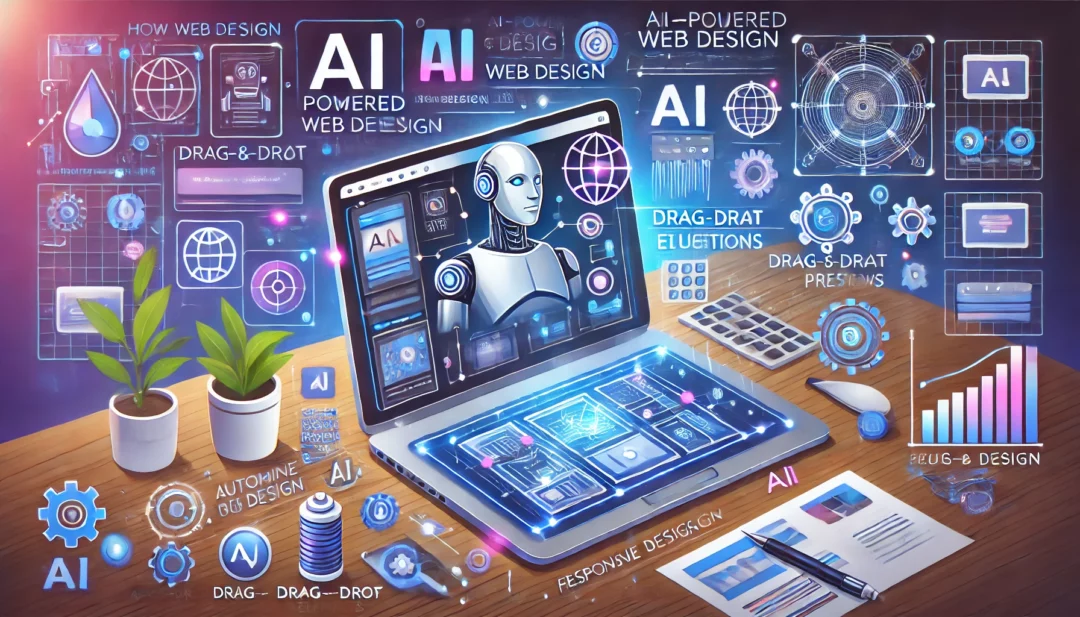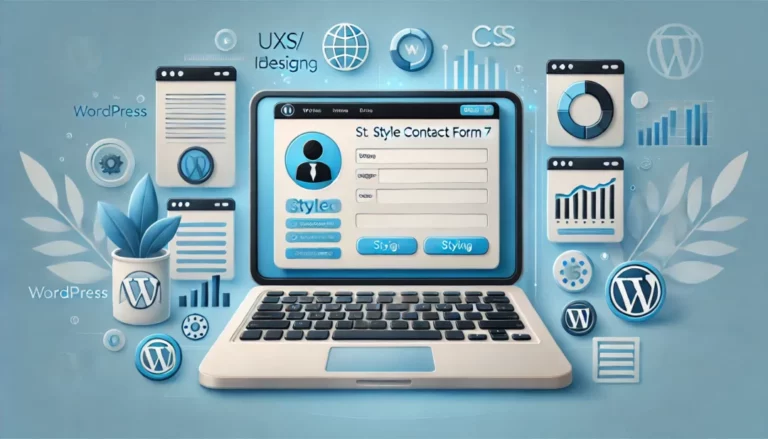
Designing websites with AI is transforming how you approach web development. It streamlines the process, saves time, and boosts creativity, making it accessible even if you’re not a coding expert. With AI tools, you can create professional, user-friendly designs that cater to your audience’s needs.
To get started, define your website’s purpose and target audience. Choose an AI-powered platform or tool that fits your goals. Use the AI features to generate layouts, color schemes, and content suggestions. Customize the design to align with your brand and ensure it’s mobile-friendly. Finally, test your site for functionality and optimize it for SEO.
Understanding AI In Web Design
AI in web design simplifies creating and optimizing websites. It integrates algorithms and machine learning to automate design tasks, enhance aesthetics, and improve user experiences.
What Is AI In Web Design?
AI in web design refers to using artificial intelligence technologies to assist in designing, building, and refining websites. This includes automating repetitive tasks, like generating responsive layouts or optimizing images, and offering suggestions for visual elements, like fonts or color palettes, based on user preferences.
AI-powered tools analyze data and predict design trends. For instance, these tools may study user behavior to recommend better navigation structures or prioritize mobile responsiveness. Developers and non-technical users can leverage such tools to save time and ensure modern designs.
Benefits Of AI-Powered Website Design
AI improves efficiency, creativity, and personalization in website design. Its advantages impact design quality, project timelines, and user satisfaction.
- Speed and Efficiency: By automating tasks like layout creation or design adjustments, AI reduces development time significantly. Tools like Adobe Firefly or Wix ADI help create drafts in minutes.
- Personalization: AI leverages user data to craft tailored experiences, such as dynamic content or personalized interfaces. Examples include displaying product suggestions or localizing landing pages.
- Consistency: Adaptive algorithms maintain design uniformity by standardizing elements like typography, spacing, and alignment throughout the site without manual corrections.
- Cost Reduction: Advanced templates and automated features lower the need for professional intervention, resulting in fewer resource requirements and reduced expenses.
Adopting AI for web design supports both creative and technical goals, setting you up for a competitive edge in the digital landscape.
Tools For Designing Websites With AI
AI design tools streamline web development by automating repetitive tasks and providing intuitive features for customization. These tools enhance creativity and efficiency while meeting modern performance and aesthetic standards.
Popular AI Design Tools
- Wix ADI
Wix ADI (Artificial Design Intelligence) generates website layouts, color schemes, and content suggestions based on your inputs. It ensures mobile responsiveness and integrates SEO features for better online visibility.
- Squarespace AI Tools
Squarespace uses AI for automated design adjustments, content recommendations, and layout optimizations. It’s ideal for creating visually appealing designs with ease.
- Zyro Website Builder
Zyro incorporates AI-driven branding tools like a logo maker, content generator, and heatmap analysis to improve user experience and design accuracy.
- Figma with AI Plugins
Figma supports collaborative design and integrates AI plugins for automated UI/UX improvements, layout recommendations, and prototype generation.
- Bookmark AiDA
Bookmark AiDA (Artificial Intelligence Design Assistant) uses machine learning to create fully operational websites in minutes, requiring minimal technical knowledge.
- Customizability
Look for tools offering manual design adjustments to ensure unique branding. Options like drag-and-drop editors enhance user control.
- Responsive Design
Tools with built-in mobile optimization ensure your website looks professional across devices. Check for adaptive layouts and media scaling features.
- SEO Integration
Prioritize tools with integrated SEO features, such as metadata suggestions and keyword optimization, to improve search engine rankings.
- Content Creation Assistance
AI tools providing automated text, image, and video generation simplify content workflows.
- Analytics and Feedback
Features like heatmaps and behavior analytics help refine design choices based on user interaction.
- Third-Party Integrations
Compatibility with plugins, e-commerce platforms, and marketing tools enhances functionality and scalability.
These tools and features deliver efficiency, adaptability, and user-centric designs, enabling you to create professional websites with minimal effort.
Steps To Design Websites With AI
Leverage AI tools to simplify the web design process while maintaining professional aesthetics and functionality. Follow these structured steps to create an efficient and visually appealing website.
Planning Your Website Structure
Define the website’s goal and target audience to create a solid foundation. Establish the website’s core purpose, whether it’s e-commerce, portfolio display, or informational content, to guide the design process. Focus on user experience by organizing content into logical sections like homepage, about page, product pages, and contact forms. Use AI-powered sitemap generators, such as Octopus.do or VisualSitemaps, to streamline this step.
Prioritize essential content and page flow to ensure easy navigation. Use wireframe tools paired with AI assistance to visualize layouts quickly. For example, Figma’s AI plugins can help suggest layout elements based on your input.
Using AI For Visual Design
Enhance visual appeal with AI-driven design features. Tools like Canva and Adobe Firefly generate cohesive color schemes, logos, typography, and other graphical elements tailored to your specifications. Upload a brand logo or preferred colors to ensure consistent themes throughout the website.
Test different visual layouts, experimenting with AI suggestions for headers, images, and buttons. Tools like Wix ADI analyze your content and offer pre-designed templates optimized for engagement. Make sure all elements, from fonts to images, align with your brand identity and message.
Automating Code And Development With AI
Accelerate coding processes using AI-assisted tools. Platforms like GitHub Copilot and Tabnine generate code snippets based on your requirements, reducing manual coding time. Drag-and-drop site builders with AI integration, such as Webflow, can automatically develop HTML, CSS, and JavaScript while allowing tweaks.
Check functionality with automated testing features in tools like Selenium or Testim to identify potential issues. Ensure the final website is responsive across devices, fast-loading, and SEO-friendly to improve overall performance.
Challenges And Limitations Of AI In Web Design
AI has transformed web design by automating processes and enhancing efficiency. However, specific challenges and limitations impact its effectiveness, requiring careful consideration during implementation.
Common Issues With AI-Driven Design
- Lack of Human Context: AI tools analyze data patterns but can’t fully understand your brand’s tone, mission, or emotional appeal. Without proper guidance, this can lead to generic or mismatched designs.
- Limited Creativity: While AI generates creative outputs, it often lacks genuine innovation. For example, AI may replicate existing trends rather than introducing unique features that set your website apart.
- Customization Constraints: AI relies on predefined algorithms, limiting customization options. Complex layouts or niche functionality demands are harder to achieve through AI-driven designs.
- Technical Glitches: Errors like improper code generation or layout bugs can occur if AI misinterprets inputs. Regular testing is necessary to identify and fix these issues.
- Dependency on Data Quality: AI effectiveness depends on high-quality data inputs. Poor or incomplete data leads to irrelevant design suggestions or errors in implementation.
- Define Clear Parameters: Establish your creative vision, brand identity, and target audience before relying on AI. Providing precise inputs improves output relevance.
- Consider Human Oversight: Incorporate manual adjustments into AI-generated designs to avoid non-contextual outcomes. Use AI for foundational work and enhance it with human creativity.
- Focus on Strategic Planning: Use AI for efficiency, like automating repetitive tasks, but don’t over-rely on it for core artistic decisions. Let human designers handle website aesthetics and user experience.
- Invest in High-Quality Data Sources: Ensure datasets provided to AI tools are accurate, detailed, and relevant. For example, uploading organized branding material yields results more aligned with your vision.
- Adopt AI as a Collaborative Tool: Treat AI as a supportive partner rather than a replacement for human designers. Combining machine precision with creative ingenuity ensures unique and practical designs.
Future Trends In AI Website Design
AI is transforming web design through continuous technological advancements and evolving roles for designers. Staying informed about emerging trends helps you effectively leverage these innovations.
Advancements In AI Technologies For Web Design
AI technologies in web design are advancing rapidly, enabling more precise automation and personalization. Generative AI models like ChatGPT and DALL·E 3 create high-quality content, images, and prototypes tailored to user preferences. These models help reduce development time and improve creative output.
Machine learning algorithms analyze user behavior to design adaptive interfaces. For example, AI-powered platforms employ predictive analysis to adjust layouts or content based on real-time data, ensuring an optimized user experience.
Voice and visual search support is becoming essential in modern website design. AI tools can integrate voice recognition features or enhance visual search capabilities, expanding accessibility and usability for diverse audiences.
Natural language processing (NLP) algorithms refine automated content creation. NLP-based tools provide suggestions for headlines, improve readability, and localize content effectively for global audiences.
The Role Of Designers In An AI-Driven World
In an AI-driven design landscape, your role shifts from repetitive tasks to strategic decision-making. Designers focus more on defining creative visions, ensuring brand consistency, and optimizing user-centric designs.
Collaborative work between you and AI ensures a balance of creativity and efficiency. AI generates design suggestions, but you refine and humanize these ideas to meet specific client needs.
Ethical considerations become a critical part of your role. Safeguarding user data, avoiding design biases, and ensuring inclusivity in AI-generated content require your oversight.
Skill diversification is essential to remain competitive. Learning data analysis, algorithm interpretation, and AI tool management enhances your ability to work effectively in AI-assisted design projects.
Conclusion
Designing websites with AI opens up endless possibilities for efficiency, creativity, and innovation. By integrating AI tools into your workflow, you can streamline complex processes, reduce development time, and focus on crafting a user-centric experience.
While AI offers remarkable advantages, it works best when combined with your unique vision and strategic input. Treat it as a collaborative partner that enhances your creativity rather than replacing it.
As AI continues to evolve, staying informed about new tools and trends will help you maintain a competitive edge. Embrace the potential of AI while prioritizing thoughtful design and ethical practices to create websites that truly stand out.
Frequently Asked Questions
What is AI in web design?
AI in web design refers to the use of artificial intelligence technologies to assist in designing, building, and refining websites. It automates repetitive tasks, suggests creative design elements, analyzes user preferences, and optimizes functionality while improving efficiency and user experience.
How does AI make web design more efficient?
AI automates time-consuming tasks such as generating layouts, color schemes, and content. It uses machine learning algorithms to suggest personalized designs and ensures responsive, mobile-friendly websites while reducing the need for manual coding.
What are the benefits of using AI-powered web design tools?
AI-powered tools enhance speed, efficiency, and personalization. They enable consistent designs, reduce costs, and allow non-coders to create professional websites. These tools also improve SEO, functionality, and user-centric designs, giving users a competitive edge.
What are some popular AI tools for web development?
Some popular AI tools include Wix ADI, Squarespace AI Tools, Zyro Website Builder, Figma with AI Plugins, and Bookmark AiDA. These tools automate tasks, enhance creativity, and ensure high-performance, aesthetically pleasing, and user-friendly websites.
How can I create a website using AI?
Start by defining your website’s purpose and target audience. Use AI-powered sitemap generators, design tools like Canva or Adobe Firefly, and coding assistants like GitHub Copilot. Customize your design, ensure mobile-friendliness, and optimize for SEO before launch.
What challenges does AI face in web design?
AI can struggle with understanding human context, produce generic designs, and limit customization due to algorithm constraints. It may misinterpret inputs, face technical glitches, or lack innovative creativity. Its effectiveness also depends on high-quality data.
How can I address the limitations of AI in web design?
To overcome AI limitations, provide clear guidelines, maintain human oversight, and use AI as a collaborative tool. Focus on strategic planning and invest in accurate data sources to ensure designs align with your unique vision and brand identity.
What future trends are shaping AI in web design?
Future trends include advanced generative AI like ChatGPT and DALL·E 3, enabling faster content creation and personalization. Designers will focus on strategic roles such as defining creative visions and ensuring ethical considerations like privacy and unbiased designs.
Is AI replacing human web designers?
No, AI is not replacing human designers but complementing them. It handles repetitive tasks, allowing designers to focus on creativity, strategy, and branding. AI is best used as a collaborative tool to enhance human creativity and efficiency.
What skills should designers learn to stay competitive in AI-driven web design?
To remain competitive, designers should diversify their skills by learning data analysis, understanding AI tools, and focusing on strategic, creative, and ethical aspects of web design. This ensures adaptability in an evolving AI-driven landscape.






